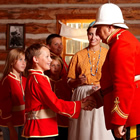A smart way to get kids learning: part 3 of 6
Marshall Carroll of Canada's Smartest Person helps parents respect all forms of intelligence

When Marshall Carroll of Winnipeg entered CBC’s contest to find Canada’s Smartest Person, he was one of thousands that applied and one of only four that were chosen to appear on the show. Carroll, a high school chemistry teacher and part-time university chemistry professor, loves to engage his students—and what better way than to have their teacher appear on television?
“I like to do role playing and things like that in my class and I think things like that help drive the point home,” said Carroll. “Because teaching chemistry can at times be quite abstract, so when I’m in the mood I go all out, and the students appreciate it. They’ll come up to me afterwards and say thank you for that lesson, or I get it now, I understand now, because you gave an analogy, or you did a role play, and that feels good.”
In the same way, Carroll believes we can all engage our own kids, especially when we take them out into nature for a hike or on a camping trip. The key is to be aware of the nine different forms of intelligence that the show on CBC featured. Part three of this six-part series takes a look at how you can engage your kids linguistically and help them both hear and tell the stories nature has to offer.
Linguistic intelligence
Nature may not seem the ideal place to tap into your child’s linguistic side, but understanding spoken and written languages and learning to express them is something that’s very important when learning the history of a place, a person, wildlife or other things found in nature. It’s also a great tool to develop within kids so that they can in turn share that history with others.
“Visitors centres and parks programs are a great way to learn the history of a visited area,” said Carroll. “Reading printed placards within the centre, going on guided tours of indoor and outdoor areas and taking part in living history exhibits that place you right into the thick of things help kids to learn and share these stories and helps teach kids that more than just a great place to camp, some of the areas you visit also have a story of their own to tell.”
Letting kids explore so that they can have some stories of their own to tell is something Carroll feels is an important part of the outdoor experience, no matter what their age.
“It doesn’t matter the age of the kids—they can be young or they could be teenagers—just let them explore,” said Carroll. “Everyone worries too much about things like ‘Oh, don’t go into that bush, you’ll get poison ivy.’ Well, so they do—it’ll be a good learning experience and a good story when they’re older.”
Here are a few ways to stimulate kids linguistically and getting them talking:
1. Show kids how they can use a shoebox and tinfoil to make a solar oven to make s’mores. Using solar energy versus burning a fossil fuel like wood can get them talking about fossil fuels and the environment.
“It’s a pretty powerful way of showing kids we’ve got to think of different ways,” said Carroll.
Keep them talking by having kids list others ways they can save the environment while out camping.
2. Let kids listen to oral histories at attractions, whether they are taped versions played in a display or live presentations given by guides or elders. Hearing people tell stories directly helps to engage a child’s imagination.
3. After learning a bit about the area’s natural history, have kids create their own bingo cards with words or pictures, depending on their ages. When out on hikes or exploring, they can then mark off those items they see or experience firsthand.
4. When looking at the night sky and identifying constellations, have kids describe what it is they see in the stars and have them come up with the stories to go along with what they see.
5. Collect rocks or pieces of driftwood while you’re out hiking and create your own inuksuk from the pieces. Have kids create a story to go along with their creation.
6. Encourage kids to take part in the hands-on activities offered at the many parks and attractions. Taking part in historic re-enactments or getting down and dirty in archaeological digs will increase the chances that the stories associated will be more firmly entrenched in a child’s memory.
7. Learn some campfire songs. The musical quality and the rhythm of words strengthen linguistic abilities. Try some old favourites like: Down By the Bay; There Was an Old Lady Who Swallowed a Fly; On Top of Spaghetti; John Jacob Jingleheimer Schmidt; Purple Stew; Baby Bumble Bee and more. You can often find MP3s of the songs to download, which lets you play and learn the songs as you travel to your destination.
8. Take one of Carroll’s favourite ideas and make it your own: “I love the number seven, and when engaging my students I’ll often have them list things quickly in sevens,” said Caroll. Have kids name seven things with a common theme, such as types of insects, fun things to do on a camping trip, colours of the rainbow, flowers, etc.
9. Download an app from the Audubon Society that gives you examples of many different types of bird calls. Listen to them with your kids, then have the kids try to repeat them and see if they get a reply.
10. Tell ghost stories around the campfire. You’ll want to make sure that stories are age-appropriate, but telling tales around the campfire is a great way to build your child’s storytelling abilities.








